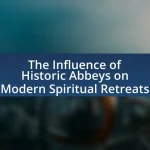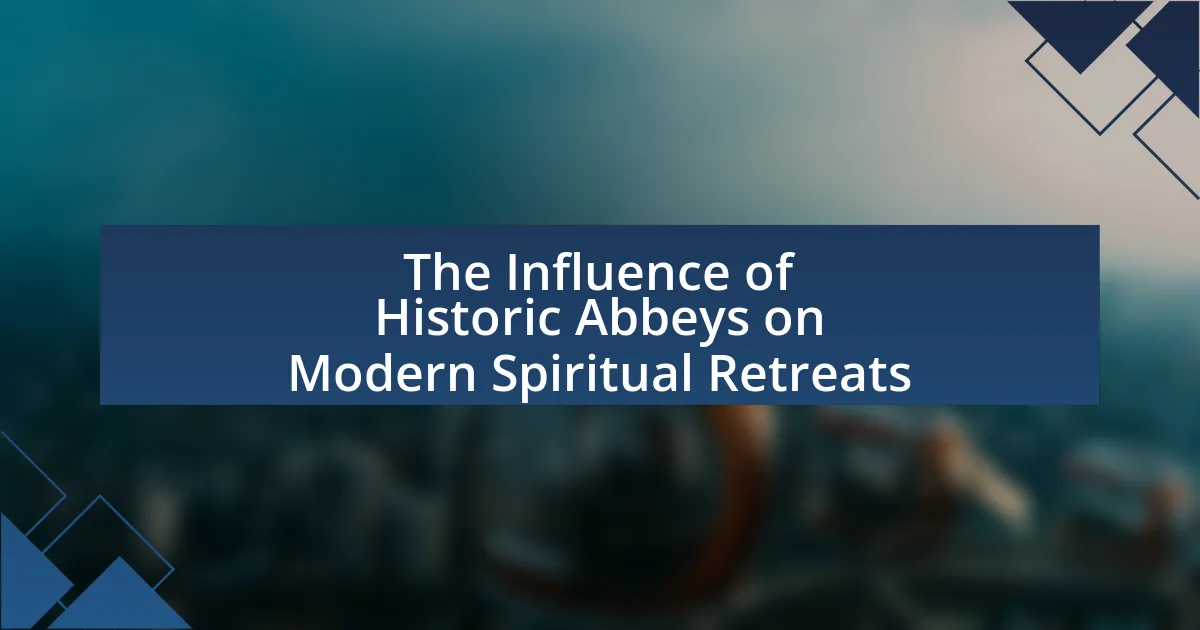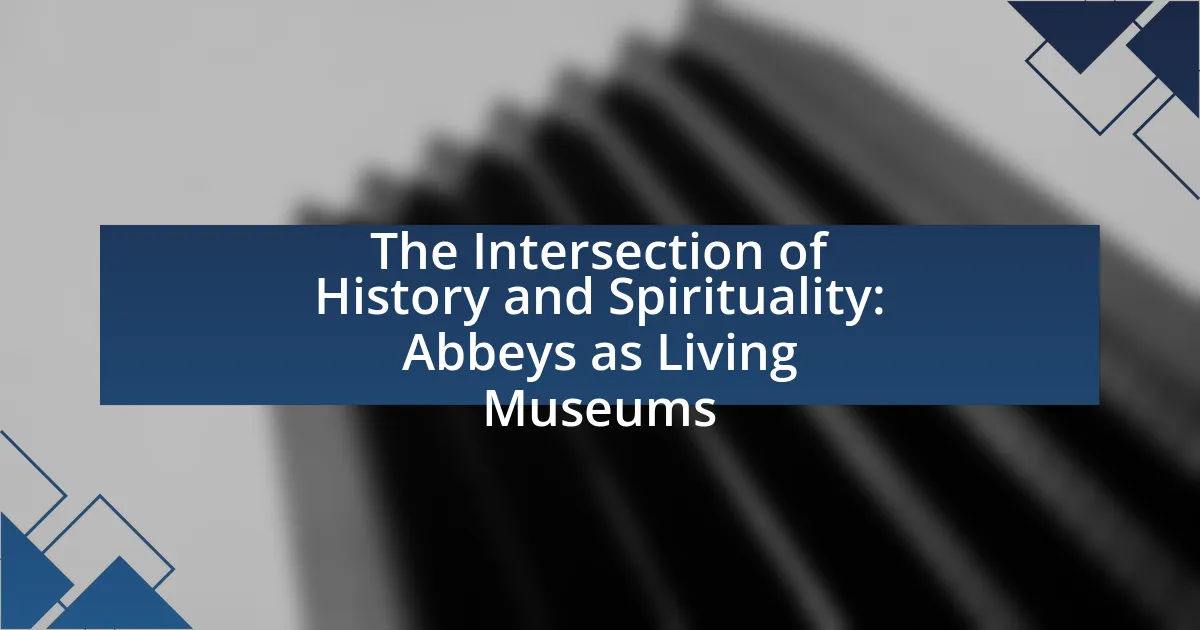Monastic communities are pivotal in shaping spiritual tourism by offering authentic experiences that foster personal growth and reflection. These communities provide structured environments for meditation, prayer, and spiritual guidance, attracting visitors to significant sites such as the Benedictine Abbey of Monte Cassino and the Shaolin Temple. The article explores how monastic practices, such as retreats and communal prayers, enhance the spiritual journey of tourists while also addressing the historical significance and architectural appeal of these sites. Additionally, it examines the balance monastic communities maintain between tourism and their spiritual missions, the challenges they face, and the best practices they can adopt to improve visitor engagement and satisfaction.
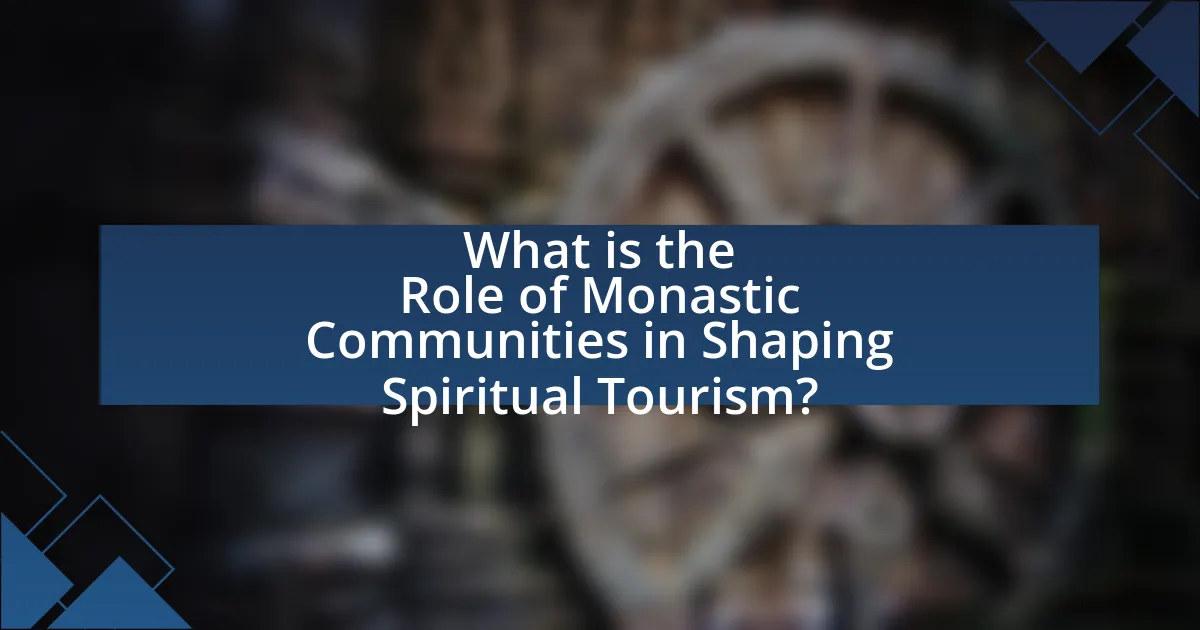
What is the Role of Monastic Communities in Shaping Spiritual Tourism?
Monastic communities play a crucial role in shaping spiritual tourism by providing authentic spiritual experiences and fostering a sense of community among visitors. These communities often serve as centers for meditation, prayer, and reflection, attracting individuals seeking spiritual growth and tranquility. For instance, monasteries like the Benedictine Abbey of Monte Cassino in Italy and the Shaolin Temple in China have become pilgrimage sites, drawing tourists interested in their rich spiritual traditions and practices. The structured environment and teachings offered by monastic communities enhance the spiritual journey of tourists, making them integral to the development and appeal of spiritual tourism.
How do monastic communities contribute to the development of spiritual tourism?
Monastic communities contribute to the development of spiritual tourism by providing authentic spiritual experiences and environments that attract visitors seeking personal growth and reflection. These communities often offer retreats, workshops, and guided meditations, which allow tourists to engage deeply with spiritual practices. For instance, many monasteries have established programs that include silent retreats and teachings on mindfulness, drawing participants who are interested in enhancing their spiritual journeys. Additionally, the historical and architectural significance of monastic sites, such as ancient monasteries and temples, adds to their appeal, as they often embody rich cultural heritage and traditions that resonate with spiritual seekers. This combination of immersive experiences and cultural significance has led to a notable increase in spiritual tourism, with reports indicating that destinations with active monastic communities see higher visitor numbers and longer stays, thereby contributing to local economies and the preservation of spiritual traditions.
What specific practices do monastic communities offer to spiritual tourists?
Monastic communities offer specific practices such as meditation retreats, communal prayers, and spiritual guidance to spiritual tourists. These practices are designed to foster inner peace and spiritual growth. For instance, many monasteries provide structured meditation sessions that can last several days, allowing participants to immerse themselves in silence and reflection. Additionally, communal prayers, often held multiple times a day, create a sense of community and shared spirituality among visitors. Spiritual guidance is typically offered through one-on-one meetings with monks or nuns, who share insights and teachings based on their religious traditions. These practices not only enhance the spiritual experience of tourists but also align with the monastic commitment to contemplation and community.
How do monastic communities create a welcoming environment for spiritual seekers?
Monastic communities create a welcoming environment for spiritual seekers by fostering a sense of belonging and providing structured opportunities for reflection and growth. These communities often emphasize hospitality, offering accommodations and meals to visitors, which helps to create a nurturing atmosphere. Additionally, they organize retreats, workshops, and guided meditations that cater to the spiritual needs of seekers, allowing them to engage deeply with their practices. The presence of experienced monks or nuns who offer guidance and support further enhances this welcoming environment, as they share their wisdom and insights, making spiritual exploration accessible. This approach aligns with the historical role of monastic communities as centers of spiritual learning and support, evidenced by their long-standing traditions of welcoming pilgrims and seekers throughout history.
Why are monastic communities significant in the context of spiritual tourism?
Monastic communities are significant in the context of spiritual tourism because they serve as centers for spiritual growth, reflection, and authentic religious experiences. These communities often provide a serene environment conducive to meditation and contemplation, attracting visitors seeking deeper spiritual connections. For instance, many monastic sites, such as the monasteries in Tibet or the Benedictine monasteries in Europe, offer structured retreats and programs that facilitate personal transformation and spiritual awakening. Additionally, the historical and architectural significance of these sites enhances their appeal, as they often embody centuries of religious tradition and cultural heritage, making them important destinations for those interested in spirituality and history.
What historical factors have influenced the role of monastic communities in spiritual tourism?
Monastic communities have historically influenced spiritual tourism through their roles as centers of religious devotion, education, and hospitality. The establishment of monastic orders, such as the Benedictines in the 6th century, created structured environments where spiritual practices were cultivated, attracting pilgrims seeking spiritual growth and enlightenment. Additionally, the medieval period saw the rise of pilgrimage routes to significant monastic sites, such as Mont Saint-Michel in France and the monasteries along the Camino de Santiago in Spain, which became focal points for spiritual tourism. These sites often provided accommodations and spiritual guidance, further solidifying their importance in the tourism landscape. The Reformation and subsequent religious movements also shaped monastic communities, leading to the preservation of certain sites as historical and spiritual landmarks, thus continuing to attract visitors seeking a connection to their spiritual heritage.
How do monastic values enhance the spiritual tourism experience?
Monastic values enhance the spiritual tourism experience by fostering a deep sense of peace, contemplation, and community among visitors. These values, rooted in simplicity, mindfulness, and devotion, create an environment conducive to spiritual growth and reflection. For instance, many monastic communities offer structured retreats that emphasize silence and meditation, allowing tourists to disconnect from daily distractions and engage in self-discovery. Research indicates that spiritual tourism participants often report increased well-being and a stronger connection to their spiritual beliefs after engaging with monastic practices, highlighting the transformative impact of these values on their experiences.
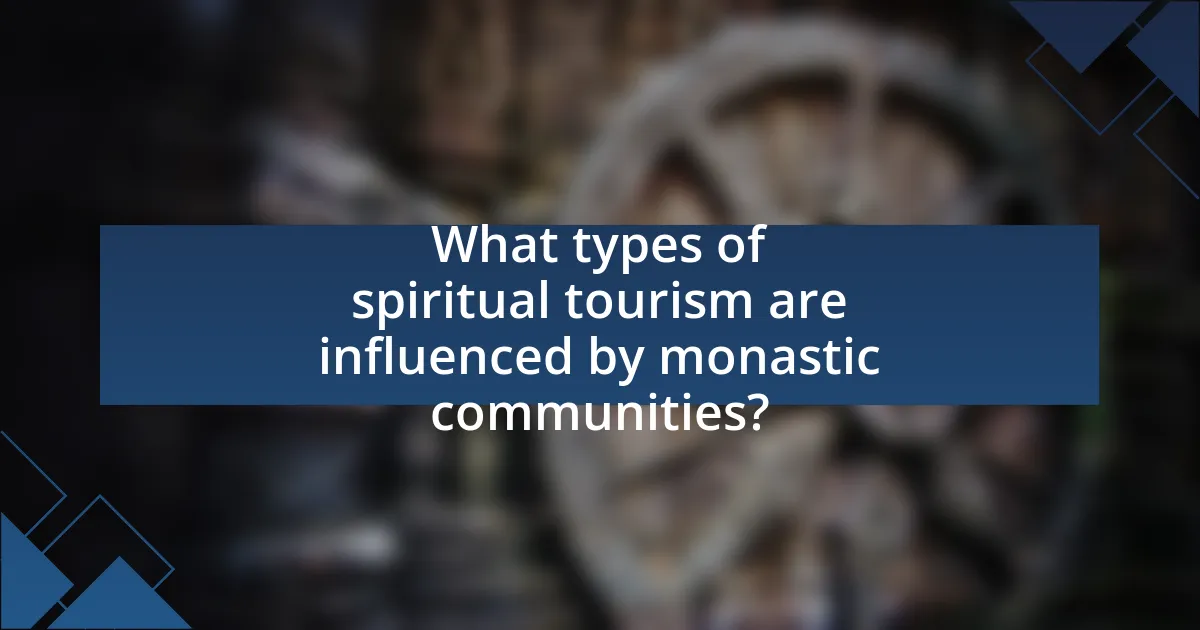
What types of spiritual tourism are influenced by monastic communities?
Monastic communities influence several types of spiritual tourism, including pilgrimage tourism, retreat tourism, and educational tourism. Pilgrimage tourism involves journeys to sacred sites associated with monastic traditions, such as monasteries or shrines, where visitors seek spiritual growth and connection. Retreat tourism allows individuals to engage in meditation, prayer, and reflection within monastic settings, often providing structured programs led by monastic members. Educational tourism focuses on learning about monastic practices, philosophy, and history, often through workshops or guided tours offered by the communities. These forms of tourism are supported by the historical significance and spiritual authority of monastic communities, which attract visitors seeking deeper spiritual experiences.
How do different forms of spiritual tourism manifest within monastic settings?
Different forms of spiritual tourism manifest within monastic settings through retreats, pilgrimages, and educational programs. Monastic communities often offer structured retreats that allow visitors to engage in meditation, prayer, and reflection, fostering a deeper spiritual experience. Pilgrimages to significant monastic sites, such as monasteries with historical or religious importance, attract tourists seeking spiritual growth and connection. Additionally, educational programs, including workshops and lectures on spirituality and monastic life, provide visitors with insights into the monastic tradition, enhancing their understanding and appreciation of spiritual practices. These manifestations are supported by the increasing interest in mindfulness and spirituality in contemporary society, as evidenced by the rise in participants in such programs and retreats.
What are the key characteristics of retreat tourism in monastic communities?
Retreat tourism in monastic communities is characterized by spiritual immersion, simplicity, and structured programs. Spiritual immersion allows visitors to engage deeply with contemplative practices, such as meditation and prayer, fostering personal growth and reflection. Simplicity is evident in the minimalist lifestyle promoted by monastic communities, encouraging participants to disconnect from modern distractions and focus on inner peace. Structured programs often include scheduled activities like workshops, silent retreats, and communal meals, which enhance the overall experience and provide a supportive environment for spiritual exploration. These characteristics are validated by the increasing popularity of such retreats, with many monastic communities reporting higher visitor numbers seeking transformative experiences.
How does pilgrimage tourism intersect with monastic practices?
Pilgrimage tourism intersects with monastic practices by serving as a conduit for spiritual engagement and community building within monastic settings. Monasteries often act as destinations for pilgrims seeking spiritual renewal, providing a space for reflection, prayer, and participation in religious rituals. For instance, the Benedictine monasteries in Europe have historically welcomed pilgrims, offering hospitality and opportunities for spiritual retreats, which enhances the monastic community’s role in fostering spiritual tourism. This relationship is evidenced by the increase in pilgrimage routes, such as the Camino de Santiago, where monasteries serve as key waypoints, illustrating the integration of tourism and monastic life in promoting spiritual journeys.
What role do monastic communities play in promoting sustainable spiritual tourism?
Monastic communities play a crucial role in promoting sustainable spiritual tourism by providing authentic spiritual experiences that emphasize mindfulness, simplicity, and environmental stewardship. These communities often operate in harmony with nature, utilizing sustainable practices such as organic farming, renewable energy, and conservation efforts, which attract tourists seeking meaningful and eco-friendly travel options. For instance, many monasteries offer retreats and workshops focused on meditation and spiritual growth, fostering a deeper connection to both the self and the surrounding environment. This approach not only enhances the visitor experience but also supports local economies and preserves cultural heritage, as seen in regions like Bhutan, where monastic tourism is integral to the country’s sustainable development strategy.
How do monastic communities balance tourism with their spiritual missions?
Monastic communities balance tourism with their spiritual missions by implementing structured visitor guidelines and designated areas for spiritual practices. These communities often establish specific times for public access, ensuring that tourists can experience the site without disrupting the monks’ daily routines of prayer and meditation. For instance, many monasteries offer guided tours that educate visitors about their spiritual practices while maintaining a respectful distance from sacred activities. Additionally, some monastic communities generate revenue through tourism, which can be reinvested into their spiritual missions, thus creating a symbiotic relationship between tourism and their religious objectives. This approach allows them to fulfill their spiritual commitments while engaging with the public in a meaningful way.
What practices do monastic communities implement to ensure sustainability in tourism?
Monastic communities implement practices such as eco-friendly building designs, organic farming, and community engagement to ensure sustainability in tourism. These communities often utilize sustainable architecture that minimizes environmental impact, such as using local materials and renewable energy sources. Additionally, many monastic communities engage in organic farming, providing fresh produce for their kitchens and reducing reliance on external suppliers, which lowers their carbon footprint. Furthermore, they foster community engagement by involving local residents in tourism activities, ensuring that economic benefits are shared and promoting cultural preservation. These practices collectively contribute to a sustainable tourism model that respects both the environment and local culture.

How do monastic communities engage with the wider spiritual tourism market?
Monastic communities engage with the wider spiritual tourism market by offering retreats, workshops, and guided spiritual experiences that attract visitors seeking personal growth and spiritual enrichment. These communities often provide structured programs that include meditation, prayer, and teachings based on their religious traditions, which cater to the growing demand for authentic spiritual experiences. For instance, many monasteries have adapted their facilities to accommodate tourists, creating serene environments conducive to reflection and learning. This engagement not only generates revenue for the communities but also fosters a deeper understanding of their spiritual practices among visitors, thereby enhancing the overall spiritual tourism landscape.
What partnerships do monastic communities form to enhance spiritual tourism?
Monastic communities form partnerships with local tourism boards, travel agencies, and cultural organizations to enhance spiritual tourism. These collaborations facilitate the promotion of monastic sites as destinations for spiritual retreats, workshops, and pilgrimages. For example, partnerships with local tourism boards often include joint marketing efforts that highlight the unique spiritual experiences offered by monasteries, such as meditation sessions and guided tours. Additionally, travel agencies may create specialized packages that incorporate stays at monastic communities, thereby attracting visitors seeking spiritual enrichment. Cultural organizations can also collaborate by organizing events that showcase monastic traditions, further enhancing the appeal of these communities as spiritual tourism destinations.
How do monastic communities collaborate with local businesses and organizations?
Monastic communities collaborate with local businesses and organizations primarily through partnerships that enhance spiritual tourism and community engagement. These collaborations often involve co-hosting events, such as retreats or workshops, where local artisans and service providers contribute their skills and products, thereby promoting local culture and economy. For instance, some monasteries offer their facilities for local farmers’ markets or craft fairs, creating a space for local vendors to showcase their goods while attracting visitors to the monastic site. This symbiotic relationship not only supports local businesses but also enriches the experience of tourists seeking authentic spiritual encounters. Additionally, monastic communities may engage in joint marketing efforts with local tourism boards to promote regional spiritual tourism, thereby increasing visibility and foot traffic for both the monasteries and local enterprises.
What marketing strategies do monastic communities use to attract spiritual tourists?
Monastic communities attract spiritual tourists through targeted marketing strategies that emphasize their unique spiritual offerings and serene environments. These communities often utilize digital marketing, including social media platforms and dedicated websites, to showcase their retreats, workshops, and events that promote spiritual growth. For instance, many monasteries create visually appealing content that highlights their tranquil settings and spiritual practices, appealing to individuals seeking peace and reflection.
Additionally, partnerships with travel agencies and spiritual tourism organizations enhance visibility and accessibility for potential visitors. Monastic communities may also engage in community outreach by hosting open days or informational sessions, allowing people to experience their lifestyle firsthand. Research indicates that spiritual tourism is growing, with a significant increase in travelers seeking authentic experiences, which monastic communities effectively capitalize on by promoting their historical significance and spiritual heritage.
What challenges do monastic communities face in shaping spiritual tourism?
Monastic communities face several challenges in shaping spiritual tourism, primarily including the preservation of their spiritual integrity and the management of visitor expectations. These communities often struggle to maintain their traditional practices and contemplative lifestyles while accommodating the influx of tourists seeking authentic spiritual experiences. For instance, the presence of large groups can disrupt the tranquility essential for monastic life, leading to tensions between the need for revenue from tourism and the desire to uphold spiritual values. Additionally, monastic communities may encounter difficulties in effectively communicating their mission and practices to visitors, which can result in misunderstandings or misrepresentations of their spiritual traditions.
How do monastic communities address the impact of commercialization on their practices?
Monastic communities address the impact of commercialization on their practices by emphasizing authenticity and spiritual integrity in their offerings. They often limit commercial activities to ensure that their primary focus remains on spiritual development rather than profit. For instance, many monasteries engage in selective tourism, where they provide guided retreats or workshops that align with their spiritual values, thus maintaining a balance between welcoming visitors and preserving their monastic way of life. This approach is supported by studies indicating that monastic communities that prioritize spiritual authenticity tend to attract visitors seeking genuine experiences rather than mere commercial transactions.
What measures do monastic communities take to maintain authenticity in spiritual tourism?
Monastic communities maintain authenticity in spiritual tourism through strict adherence to their traditional practices, regulations on visitor interactions, and the preservation of their sacred spaces. These communities often implement guidelines that limit the commercialization of their spiritual offerings, ensuring that experiences remain genuine and rooted in their religious beliefs. For instance, many monasteries require visitors to participate in daily rituals or teachings, which fosters a deeper connection to the monastic lifestyle. Additionally, they may restrict access to certain areas or activities to protect the sanctity of their environment, thereby enhancing the spiritual experience for tourists. This approach not only safeguards their traditions but also enriches the visitor’s understanding of monastic life, as evidenced by studies showing that immersive experiences lead to greater spiritual fulfillment among participants.
What best practices can monastic communities adopt to enhance spiritual tourism experiences?
Monastic communities can enhance spiritual tourism experiences by implementing structured retreat programs that focus on mindfulness, meditation, and community engagement. These programs provide visitors with immersive experiences that foster personal reflection and spiritual growth. For instance, the Trappist monasteries in the United States have successfully integrated silent retreats, allowing participants to disconnect from daily distractions and engage deeply with their spirituality. Additionally, offering guided tours that explain the history, architecture, and spiritual practices of the monastery can enrich visitors’ understanding and appreciation of the monastic lifestyle. Research indicates that such educational components significantly enhance visitor satisfaction and spiritual fulfillment, as seen in studies conducted by the International Journal of Religious Tourism and Pilgrimage.
How can monastic communities improve visitor engagement and satisfaction?
Monastic communities can improve visitor engagement and satisfaction by offering immersive experiences that connect visitors with their spiritual practices. These experiences can include guided meditation sessions, workshops on monastic traditions, and opportunities for visitors to participate in daily rituals. Research indicates that such participatory activities enhance visitor satisfaction by fostering a deeper understanding of monastic life and spirituality. For instance, a study published in the Journal of Tourism and Spirituality found that visitors who engaged in hands-on activities reported higher levels of satisfaction compared to those who observed passively. By creating an environment that encourages interaction and personal involvement, monastic communities can significantly enhance the overall visitor experience.
What resources are available for monastic communities to develop their spiritual tourism offerings?
Monastic communities can access various resources to develop their spiritual tourism offerings, including training programs, partnerships with tourism organizations, and funding opportunities. Training programs, such as those offered by the International Centre for Responsible Tourism, provide guidance on sustainable tourism practices tailored for spiritual settings. Partnerships with local tourism boards can enhance visibility and attract visitors, while funding opportunities from organizations like the World Monuments Fund support preservation and development projects. These resources enable monastic communities to create enriching experiences that align with their spiritual missions and attract tourists seeking meaningful engagement.

